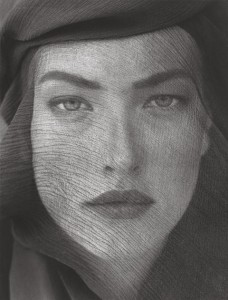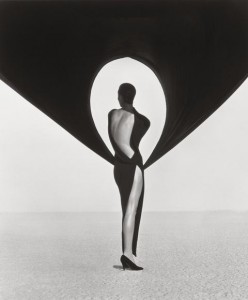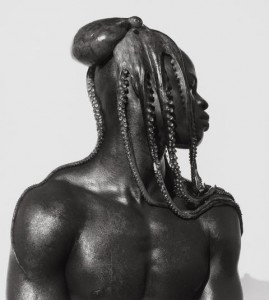Say Herb Ritts and statuesque black and white images of the world’s most beautiful people come to mind. The artist’s sleek images of famous folks in glamorous poses feel as though they’ve been part of our fame-obsessed culture forever. But Hollywood didn’t always have such a sway on our hearts and minds, and the new show, Herb Ritts: L.A. Style, which opened April 3 at the Getty, does a nice job explaining how one photographer’s vision and expertise changed fashion photography and our notions of celebrity. Learning more about Herb Ritts’ aesthetic has turned me into a fan of the artist and his work.
Ritts grew up next door to Steve McQueen and developed a familiar ease with famous folk early on, a relaxed demeanor that allowed him to develop trusting relationships with those that he photographed. He wanted the celebrity of his subjects to be subsumed into the creation of a perfect image. He shot assignments and personal work in the same manner – in fact, it’s hard to tell the difference between work created for an ad campaign and his own personal images. Ritts was always playing with light and shadow to create a beautiful image, rendering the women and men iconic and statuesque, yet allowing them a surprising humanity. As Cindy Crawford said of the man who fashioned her super stardom, “the way Herb photographed you was the way you wanted to world to see you”. 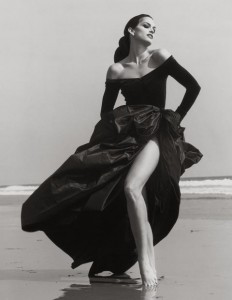 Well, perhaps posing with an octopus on your head is not how Djimon Hounsou wanted himself to be seen by the world, but this image does suggest he had a high level of trust in the artist.
Well, perhaps posing with an octopus on your head is not how Djimon Hounsou wanted himself to be seen by the world, but this image does suggest he had a high level of trust in the artist.
Ritts photographed 200 magazine covers between 1984 and 2002, several of which are included in the show and will be recognizable to visitors. After admiring several shots of a young Madonna, (including the image often known as True Blue, Madonna, Hollywood 1986), be sure to check out the case in the center of the gallery displaying a photo from a Brittany Spears session next to it’s depiction on the cover of Vogue. The original shot is marked up for the air-brushers – a nice lesson for all teenagers! The case also includes the camera the Ritts used to take the photo that launched Richard Gere’s career, which is also in the gallery.
According to the exhibit materials, Herb Ritts’ photography returned Hollywood’s sullied, sad image to its former status as the heart of glamor, photographing beautiful human specimens against the incredible, stark beauty of Los Angeles. The show presents some of the most recognizable of the photographer’s work, but Curator John Martineau, who had access to the extent of the Herb Ritts archives, decided that the show should contain primarily lesser known images so that viewers could understand the breadth of Ritts’ vision and talent. By studying the lesser known work, we can see how Ritts restored a sense of Hollywood glamor, and raised the status of the nude portrait, as well.
Of course, much of the work is of nude figures – both male and female – so this exhibit is not appropriate for smaller visitors. (Although, a visit to any museum includes plenty of glimpses of the nude form!).
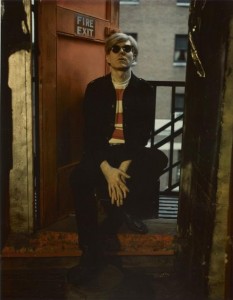 A second show, Portraits of Renown: Photography and the Cult of Celebrity, contained within the gallery, presents a collection of celebrity portraits from the Getty’s own collection of photographs. Frankly, this this show would be worth the trip even without the clever juxtaposition with Ritts’ work – just to see wonderful portraits of folks as diverse as Mark Twain, Bob Dylan, Edna St. Vincent Millay, Pablo Picasso and many, many more. There’s even a slightly creepy Diane Arbus shot of Anderson Cooper as an infant. And no exhibit about celebrity would be complete without an image of the master of image manipulation, Andy Warhol.
A second show, Portraits of Renown: Photography and the Cult of Celebrity, contained within the gallery, presents a collection of celebrity portraits from the Getty’s own collection of photographs. Frankly, this this show would be worth the trip even without the clever juxtaposition with Ritts’ work – just to see wonderful portraits of folks as diverse as Mark Twain, Bob Dylan, Edna St. Vincent Millay, Pablo Picasso and many, many more. There’s even a slightly creepy Diane Arbus shot of Anderson Cooper as an infant. And no exhibit about celebrity would be complete without an image of the master of image manipulation, Andy Warhol.
Herb Ritts: L.A. Style April 3-August 26, 2012
Portraits of Renown: Photography and the Cult of Celebrity April 3-August 26, 2012
Who Should Go: Adults, tweens and teens (as long as they aren’t upset by nudity)
Discussion Points for your family:
1. It is said that Ritts revolutionized fashion photography, so it’s fun to try to figure out what Ritts was selling in some of the images in the show (esp. in the Fashion and Art and Commerce rooms). For instance, in the fashion shots – does he put the article of clothing at its best advantage, or is he interested in finding a symmetrical, well-lit way to present another beautiful body? Consider the photo of the man’s back who has only socks on, or the woman image of only the neckline of a dress and chin of the model. He was hired by Tag Hauer to shoot top athletes and dancers, but see if you can find a watch on anyone’s body!
2. Considered a master of photographing celebrities, Ritts held a certain celebrity status himself – it was considered a rite-of-passage for a model or star to sit for a portrait with Ritts. He was born into a wealthy family, and went on to make millions as a photographer and filmmaker. Before he died (of AIDS in 2002), he established the Herb Ritts Foundation that gives money to the charities he supported in his lifetime. Is this generosity of spirit and heart an unusual quality in today’s world?
Photo credits:
Tatjana, Veiled Head, Joshua Tree, 1988 (Herb Ritts)
Versace Dress, Back View, El Mirage, 1990 (Herb Ritts)
Djimon with Octopus, Hollywood, 1989 (Herb Ritts)

